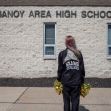An angry ninth-grader who just learned she didn’t make the varsity cheerleading squad posted a message on social media. It included what her public school considered offensive gestures and language. She was removed from the cheerleading squad and sued her school. She won her case in the lower courts, and now the U.S. Supreme Court has been asked to decide whether students’ off-campus speech may be regulated.
Due to the current conflict in how U.S. Circuit Courts are viewing a 1969 ruling that held that K-12 schools can discipline students for their off-campus speech, the Supreme Court may decide to hear the case from the petitioner, the Mahanoy Area School District in Pennsylvania, which lost in the Third Circuit Court of Appeals. Respondents are B.L., a minor, and her parents, represented by the American Civil Liberties Union.
At issue is the ruling in Tinker v. Des Moines Independent Community School District, a case that balanced students’ First Amendment rights in school with the schools’ obligations “to prescribe and control conduct in the schools” if the speech “would materially and substantially interfere with the requirements of appropriate discipline in the operation of the school.”
Respondent’s brief said that the First Amendment protected B.L.’s “colorful expression of frustration, made in an ephemeral Snapchat on her personal social media, on a weekend, off campus, containing no threat or harassment or mention of her school, and that did not cause or threaten any disruption of her school.”
Until the Third Circuit's opinion last August, five circuits and the Pennsylvania Supreme Court agreed that Tinker gives school administrators the right to discipline off-campus student speech that has a “close nexus” to the school environment and threatens to disrupt it.
In a divided opinion, the Third Circuit ruled that Tinker never allows schools to punish off-campus speech. It held that off-campus speech is “beyond the school’s power to discipline…even if (it) is closely connected to campus, seriously disrupts the school environment, and threatens or harasses other students or administrators.” The court also said that school personnel would be subject to money damages in subsequent civil rights suits.
Tinker, of course, came well before social media was even imagined and well before the pandemic forced the majority of education to take place virtually and online. At issue are not only the rights of youngsters who rely on social media for much of their interpersonal communication, but the practicality of monitoring its use. Imagine the personnel that would be needed to oversee the Facebook, Twitter, Snapchat, emails, texts and other online activities of more than 31 million kids at over 60,000 schools who want to share feelings with their communities.
Speaking to the New York Times, Yale Law Professor Justin Driver, who wrote “The Schoolhouse Gate: Public Education, the Supreme Court and the Battle for the American Mind,” said “In the modern era, a tremendous percentage of minors’ speech occurs off campus but online…Judicial decisions that permit schools to regulate off-campus speech that criticizes public schools are antithetical to the First Amendment. Such decisions empower schools to reach into any student’s home and declare critical
statements verboten, something that should deeply alarm all Americans.”
The facts of this case likely mirror the behavior of scores of angry and distraught kids throughout the world. Now a sophomore, B.L. learned that even though she made Junior Varsity cheerleader in her freshman year, she would remain on the Junior Varsity squad again, while a new freshman was given what she thought was her spot. In response, she took to Snapchat and sent two messages. The first was a photo that showed her and a friend with their middle fingers in the air. The second message used the f*** word as an adjective four times before the words school, softball, cheer and everything.
B.L.’s hurtful and angry message was sent to 250 Snapchat friends, one of whom had a mother who forwarded it to a cheerleading coach. Petitioners claim that B.L.’s fellow students were “visibly upset” and therefore “felt the need to enforce (the relevant school rules) against B.L. to avoid chaos and maintain a team-like environment.” They cited school requirements that cheerleaders respect the school, avoid foul language and inappropriate gestures, avoid posting any negative information regarding cheerleading on the internet, and conduct themselves in a way that does not tarnish the image of their school district.
B.L. was removed from the squad but told she could try out again next year. The lawsuit followed, and the District Court granted her motion for summary judgment, holding her dismissal violated her First Amendment rights because her messages were “insufficiently disruptive for the school to discipline.” It acknowledged that Tinker’s application to speech “uttered beyond the school house gate” remains undecided. The Third Circuit went further, holding schools could never punish off-campus speech.
Petitioners cited the need for schools to be able to provide a “safe school environment conducive to learning.” It argued the value of the Tinker precedent that had been used in “nearly a dozen decisions spanning two decades, five circuits and a state supreme court concluded schools may address off-campus speech with a connection to the school environment.” Primarily, however, it asked the Supreme Court to provide clarity to school administrators who now face different standards for disciplining students’ speech in state and federal courts. “The split could not be more stark,” it stated.
Petitioner also cites several recent lawsuits that demonstrate the difficulty of defining what would interfere with the requirements of appropriate discipline in the operation of the school. These suits allowed disciplinary measures for students in Michigan who used the phrases “white power” and said the “South will rise again”; for an anti-Semitic rant that said “(m)e and the boys bout to exterminate the Jews”; and for another post that featured photos of guns after the Parkland shooting. Are words that promote racism and cyberbullying too extreme to escape punishment? Where should the line be drawn?
The Third Circuit’s decision to prohibit schools from punishing off-campus speech had been called a “bona-fide bombshell,” “historic,” and “huge” by various commentators. The New York Times noted that although Chief Justice Roberts is known as a staunch First Amendment defender, his decisions related to student speech are less vigorous. “The court has been methodically cutting back on students’ First Amendment rights since the Tinker decision in 1969,” wrote reporter Adam Liptak. “And in the court’s last major decision on students’ free speech, in 2007, Roberts wrote the majority opinion, siding with a principal who had suspended a student for displaying a banner that said, “Bong Hits 4 Jesus.”
Now, Tinker’s fate and the fate of young people who feel they have been mistreated, disrespected or disciplined for putting their feelings online is up to the U.S. Supreme Court.






